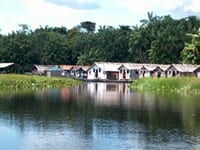



This book contributes to the debate on land use in the Brazilian Amazon. The authors make four conclusions. First, they demonstrate that increasing levels of rainfall undermine agriculture productivity and sustainability. Second, they assert that in the majority of the Amazon sustainable forestry would provide more stable communities than agriculture. Third, they conclude that regulatory competition and a short local political time horizon prevent sustainable forestry from being adopted, despite its better long-run performance. Finally, some 10 percent of the Amazon could be put into national forest in a way that would both meet current and future demand for amazonian timber.
This post was published on 18 de September de 2008
Several authors. System for Monitoring Timber Harvesting (Simex): Mapping of logging in the Brazilian Amazon…
Souza Jr, Carlos M; Marengo, José; Ferreira, Bruno; Ribeiro, Júlia; Schirmbeck, Lucimara W; Schirmbeck, Juliano;…
Several authors. System for Monitoring Timber Harvesting (Simex): Mapping logging in Amazonas State – August…
Several authors. System for Monitoring Timber Harvesting (Simex): Mapping logging in Roraima State – August…
Several authors. System for Monitoring Timber Harvesting (Simex): Mapping logging in Amapá State – August…
Several authors. System for Monitoring Timber Harvesting (Simex): Mapping logging in Pará State - August…